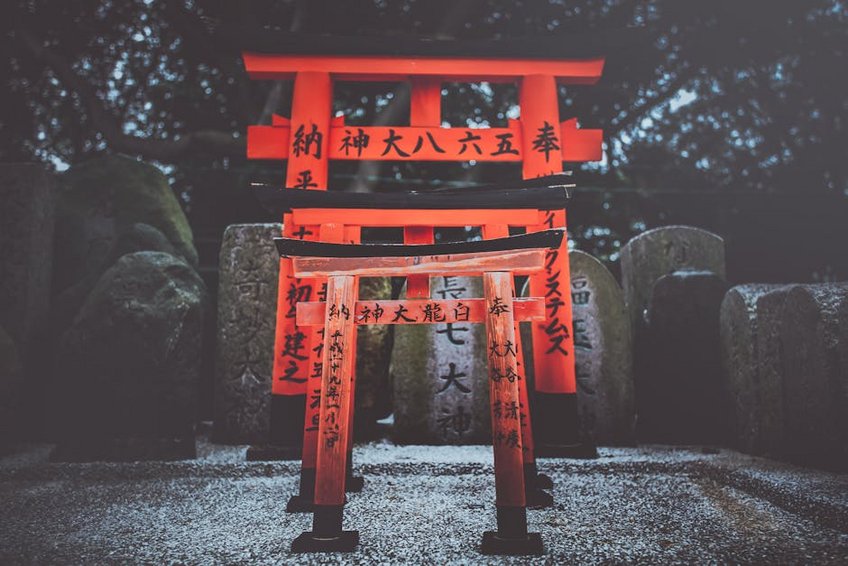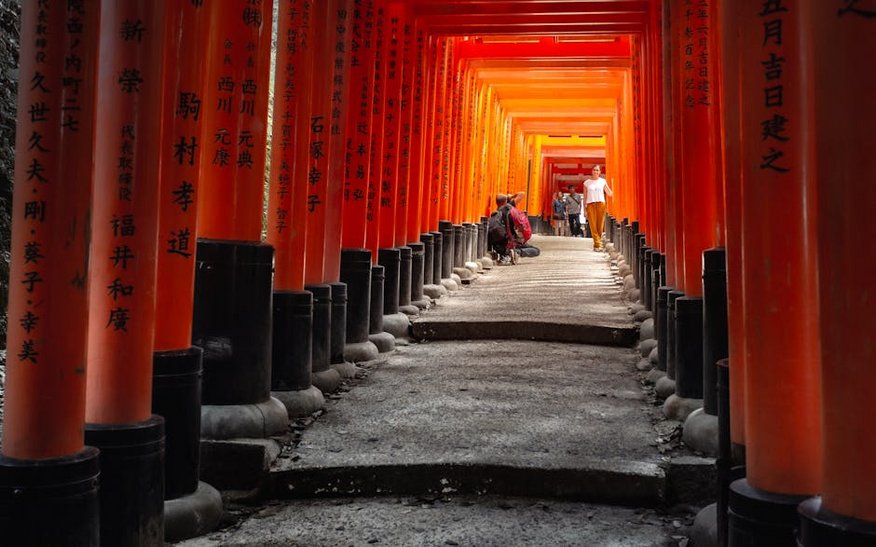Kyoto Fushimi Inari Shrine: Ultimate Guide to Japan’s Iconic Gates
When you imagine Japan, chances are you picture the mesmerizing path of thousands of vibrant orange torii gates winding up a forested mountain. That iconic image comes from one place: Kyoto Fushimi Inari Shrine, Japan’s most important Shinto shrine dedicated to Inari, the god of rice, sake, and prosperity. Visiting this spiritual landmark isn’t just about taking photos for your Instagram feed—it’s about experiencing centuries of Japanese culture, spirituality, and natural beauty woven together in a way that will leave you genuinely moved. Unlike many tourist attractions that feel manufactured, Fushimi Inari maintains an authentic spiritual atmosphere where you’ll witness locals praying alongside tourists, especially during early morning hours when the light filters magically through the gates. Whether you’re a spiritual seeker, history enthusiast, or simply someone who appreciates breathtaking scenery, this shrine complex offers an experience that transcends typical sightseeing and becomes something you’ll carry with you long after returning home.
Kyoto Fushimi Inari Shrine Essential Information
Before embarking on your journey to this remarkable site, understanding its historical and cultural significance will dramatically enhance your experience. Established in 711 AD—long before Kyoto became Japan’s capital—Fushimi Inari Shrine predates much of the city’s famous heritage. The thousands of torii gates that make it famous weren’t originally part of the design; this tradition began during the Edo period when businesses started donating gates as offerings for prosperity. Today, the path stretches approximately 4 kilometers (2.5 miles) up Mount Inari, with the full hike taking 2-3 hours round trip if you maintain a steady pace. What many visitors don’t realize is that the main shrine complex at the base is just the beginning—the real magic happens as you ascend through the gates into the forest, passing numerous smaller shrines, rest spots, and even tea houses along the way.
Historical Significance – More Than Just Gates
- The shrine’s founding legend involves a rice cake shot into the air that turned into a swan and flew to Mount Inari, where the deity was enshrined
- During the Edo period (1603-1868), merchant families began donating torii gates as symbolic prayers for business success
- Fox statues throughout the complex aren’t decorative—they’re considered messengers of Inari and often hold symbolic items in their mouths
- Budget travelers can experience the shrine completely free, with affordable train access (approximately $2 each way from central Kyoto) and nearby convenience stores offering meals under $8
- Mid-range visitors might budget $30-50 for a traditional meal at one of the tea houses along the path, plus souvenirs from the extensive gift shops at the base
- Luxury experiences include private guided tours ($150-300) and staying at nearby ryokans (traditional inns) offering kaiseki meals and onsen baths from $300-500 per night
- Official Fushimi Inari Taisha Website
- Japan Guide Fushimi Inari Information
Practical Visiting Details – What You Absolutely Need to Know
Unlike many Japanese attractions that charge admission or require advance booking, Fushimi Inari Shrine remains completely free and open 24/7 year-round, making it accessible to all travelers regardless of budget or schedule. The most popular approach is via JR Nara Line from Kyoto Station (just 5 minutes to Inari Station, which sits directly opposite the shrine entrance). For those using Kyoto’s subway system, the Keihan Main Line takes you to Fushimi-Inari Station, about a 7-minute walk from the entrance. While the shrine never closes, your experience will vary dramatically depending on when you visit—early mornings (before 8 AM) offer relative solitude and magical lighting, while evenings provide a completely different atmosphere with lantern-lit paths and fewer crowds than midday.

Kyoto Fushimi Inari Shrine Planning Your Trip
Strategic planning transforms your visit from a crowded photo opportunity into a profound cultural experience. While it’s tempting to follow the crowds and only see the famous gate-packed beginning section, committing to the full hike rewards you with increasingly peaceful paths, smaller shrines that feel more intimate, and breathtaking viewpoints over Kyoto that few tourists ever see. Your physical preparation matters too—while the path is well-maintained, it involves steady elevation gain with stone steps that can become slippery after rain. Proper footwear (think hiking shoes or sturdy sneakers) makes a significant difference in your comfort and safety. During summer months, Japan’s humidity demands extra water and sun protection, while winter visits require warm layers since temperatures drop noticeably as you ascend the mountain.
Best Time to Visit Kyoto Fushimi Inari Shrine
Timing your visit involves balancing weather, crowds, and seasonal beauty. Spring (March-May) brings cherry blossoms around the shrine’s periphery and comfortable temperatures, but also peak tourist numbers. Summer (June-August) offers lush green landscapes but intense heat and humidity—early mornings or late evenings become essential. Autumn (September-November) provides spectacular foliage along the path and cooler hiking conditions, while winter (December-February) offers crisp air and fewer visitors, though some facilities may have reduced hours. Regardless of season, weekdays see noticeably smaller crowds than weekends, and Japanese national holidays should be avoided if possible. For photographers, the golden hour light (shortly after sunrise or before sunset) creates magical effects through the gates, while rainy days offer moody atmospheres and reflective surfaces on the stone paths.
Budget Planning and Costs
Essential Preparation Checklist
Packing strategically dramatically improves your Fushimi Inari experience. Comfortable walking shoes with good grip are non-negotiable—the stone steps become slippery when wet, and you’ll be on your feet for hours. Carry more water than you think you’ll need, especially in warmer months, as vendors become fewer as you ascend. A small towel proves useful for both sweat and cleaning hands before prayer rituals. While cash isn’t needed for entry, bring Japanese yen for donations, food purchases, and souvenirs since credit cards aren’t widely accepted along the path. Download an offline map of the area since cell service can spotty in the mountain areas, and consider bringing a portable charger if you plan to take many photos throughout your visit.
Kyoto Fushimi Inari Shrine Top Attractions and Activities
While the torii gate tunnels understandably dominate visitors’ attention, Fushimi Inari Shrine offers layered experiences that reward those who look beyond the obvious photo spots. At the base complex, the Romon Gate (donated by Toyotomi Hideyoshi in 1589) and the main hall (Honden) provide impressive examples of Shinto architecture before you even reach the famous path. As you begin ascending, you’ll pass the iconic two-story pagoda and eventually reach the crossroads where the path splits—this is where most crowds turn back, making it the perfect opportunity to continue upward toward more serene surroundings. Approximately halfway up, the Yotsutsuji intersection offers the first spectacular viewpoint over Kyoto, complete with seating areas where you can rest while taking in the panorama. Further along, the inner shrine and summit provide quieter spiritual spaces where you might have the rare experience of having entire sections of path virtually to yourself.
Must-See Highlights Along the Route
Beyond the initial gate tunnels, several features deserve special attention. The Okusha shrine roughly halfway up features hundreds of miniature torii gates donated by visitors who couldn’t afford full-sized ones—this colorful display creates a fascinating textural contrast to the larger gates. Various sub-shrines along the path each have unique characteristics; the one dedicated to luck in studies often attracts students praying before exams. For those making the full climb, the summit shrine offers a profound sense of accomplishment and spiritual tranquility that’s noticeably different from the bustling base area. Don’t miss the opportunity to participate in traditional omikuji (fortune slips)—for a small donation (usually ¥100-200), you can receive a paper fortune that provides insight into your future, with the option to tie unfavorable fortunes to designated racks to leave the bad luck behind.
Hidden Gems and Local Favorites
Seasoned visitors know that some of Fushimi Inari’s best experiences lie off the main path. Behind the main hall at the base, a small pond filled with giant koi fish offers a moment of tranquility away from the crowds. The cemetery on the mountain’s eastern side provides a fascinating glimpse into Japanese burial traditions, with elaborate gravestones and memorials dating back centuries. For food experiences, the street leading to the shrine (called Fushimi Inari Sando) offers numerous stalls selling traditional Japanese street food like yakitori, takoyaki, and freshly grilled mochi—far superior to the options available inside the shrine grounds. Local worshippers often visit the secondary shrine dedicated to Ukanomitama-no-Mikoto, believed to bring luck in relationships, which sees fewer tourists but maintains a genuinely spiritual atmosphere.
Kyoto Fushimi Inari Shrine Practical Travel Information
Navigating your visit efficiently requires understanding the logistical aspects beyond simply arriving at the shrine. While the JR Inari Station places you directly across from the entrance, the Keihan Line’s Fushimi-Inari Station offers a more scenic approach through traditional streets lined with shops and restaurants. Within the shrine complex, clean restrooms are available at the base and at the Yotsutsuji intersection halfway up, but not along the steeper sections of the path. While the main path is well-marked in both Japanese and English, several side paths branch off to smaller shrines and cemeteries—these are worth exploring if you have time, but can be confusing without a map. For those with mobility issues, the base area and initial gate sections are relatively accessible, but the mountain path involves significant stairs and uneven surfaces that make wheelchair access beyond the beginning impossible.
| Category | Options/Features | Price Range (USD) |
|---|---|---|
| Transportation | JR Train from Kyoto Station, Keihan Line, Taxi | $2-20 one way |
| Food & Drink | Street food stalls, tea houses, convenience stores | $3-15 per item |
| Souvenirs | Fox figurines, ema plaques, torii gate replicas | $5-50 |
| Guided Tours | Group tours, private guides, audio guides | $15-300 |


